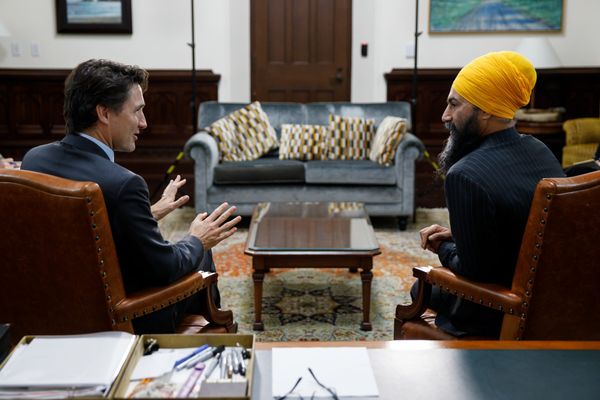The “cost of living crisis” is on the agenda everywhere. At 5.7 per cent, inflation in Canada is the highest it’s been in 30 years.
Much of the current bout of inflation is likely temporary, the result of pandemic supply chain disruptions, high fossil fuel and food prices compounded by Russia’s war in Ukraine, and prices readjusting after a year or more of COVID-related recession.
Yet, even if inflation is temporary, downplaying its immediate and long-term implications is no viable political strategy. The consequences of high inflation aren’t experienced equally across the income spectrum. For low-income workers and those on fixed income support programs, high inflation could be catastrophic. As in many other instances throughout the pandemic, new crises are layered on top of previous ones decades in the making.
Moreover, erosion of living standards over the course of several months or more will not easily be reversed once inflation recedes. The short-term losses of post-pandemic inflation could become entrenched and regressively redistribute income and wealth even further.
In other words, inflation is always and everywhere more than simply an increase in prices; it’s fundamentally a conflict over the distribution of income and wealth. Inflation produces winners and losers. We need working-class organizations and policy interventions to make sure workers are protected.
Divergent Inflation
Inflation is measured as an average change in the cost of a sample of goods — the “price basket” — using the consumer price index (CPI). The CPI states that it gives us a picture of “changes in prices as experienced by Canadian consumers.” Such a measure is convenient, but it’s also empirically misleading. Not every item you pick up in the store is now 6 per cent more expensive than it was a year ago. On some level, most people realize this. Yet the way inflation is reported — as though it’s a uniform increase in prices — largely obscures this.
Inflation will have different impacts depending on which price increases are driving it at any given time. For example, gasoline and energy costs have risen by roughly 32 and 24 per cent over the past year, respectively, while the prices of clothing, furnishings, and services have all fallen below average inflation. Current inflation is particularly troubling because the lowest quintile of households spend a disproportionately high percentage of their income on energy, housing and food.
Divergent price movements also mean that inflation redistributes income between sectors of the economy, workers and bosses, lenders and debtors, as well as between owners of capital. Typically, the largest corporations benefit from inflationary redistribution because they are the most able to increase their “mark-up,” i.e. the size of their profit margin. In other words, big corporations are essentially able to raise prices faster than everyone else, owing to their market power. There’s plenty of evidence that this has been happening throughout the pandemic. Oil companies, shipping firms, auto manufacturers and food producers, to name a few, have been “price-gouging” because market conditions and governments have allowed it.
Central banks therefore view “inflation targeting” as a public good. To a certain extent this is true. Runaway food prices, for instance, harm low-income consumers and are obviously a serious social problem. However, targeting inflation is not so simple.
The primary way central banks reduce inflation is by raising interest rates, a blunt instrument if there ever was one. By making borrowing more expensive, the Bank of Canada slows business investment and indirectly raises unemployment. Additionally, persistently low inflation can be generally harmful to the working class because this limits economic and job growth and makes it difficult for workers to obtain wage increases. Since the shift to low inflation in the ’80s, the wages of workers on the bottom end of the wage scale have stagnated and income inequality has soared.
Inflation As Class Struggle
The Bank of Canada has nevertheless now begun a course of gradual interest rate increases. By no means will this be equivalent to the drastic rate hikes of the late ’70s and early ’80s, but it is nevertheless potentially harmful to workers.
Despite the Bank of Canada admitting that raising interest rates now can have little to no impact on our largely supply-induced inflation, it’s nevertheless justifying its course of action by claiming that hiking rates will dampen “inflation expectations.” The latter theory holds that if central banks don’t act, inflation will become entrenched as both firms and workers seek anticipatory price and wage increases.
Taming “inflation expectations,” however, has much more to do with preventing workers from making wage demands. The newest deputy governor at the Bank of Canada, Sharon Kozicki, put the concern bluntly in an interview with the Toronto Star. She admitted: “Even if the initial thing [price increases] is coming from a supply shock, people see inflation. People don’t go out and say, ‘Well, this is inflation, these prices are up but it’s not because of demand, so therefore I’m not going to worry about that when it comes to thinking about my wages.’”
That’s it in a nutshell. Bay Street economists and central bankers are guarding against the dreaded “wage-price spiral,” wherein workers make wage demands to keep up with rising prices and inflation becomes centrifugal and generalized. The problem is that there’s very little evidence that this is happening, or that it could happen at all. Although wages have begun to rise, year-over-year wage growth is highly uneven across sectors and is still below inflation.
Even if the recent uptick in wage growth persists or accelerates, it’s likely to be temporary. In other words, there’s almost no chance that the current inflation panic will turn into a more generalized crisis similar to what occurred in the ’70s, despite an energy price shock being a key ingredient both then and now.
The fundamental difference between the ’70s and today is that the working class and its institutions are in shambles. Workers’ collective bargaining power is negligible after decades of decline in private sector union density. Labour’s share of national income has declined substantially from where it was back then. Presently, wage restraint legislation is holding public sector wages down in Ontario and Alberta, and has done so recently in Manitoba and New Brunswick. Any momentary wage pressure that exists is therefore coming from a relatively tighter labour market — a situation that is unlikely to last. Without the power of unions, the vast majority of workers are unable to make significant wage gains.
Part of the commitment to “build back better” involved recognizing that throughout the past couple of decades we’ve been living through a low-level economic depression, characterized by slow growth, lacklustre business investment and wage stagnation. Post-pandemic, there was ostensibly an opportunity to increase fiscal stimulus, pursue higher economic growth and allow a tighter labour market to push wages up. With inflation now a pressing concern, the political class seems entirely willing to abandon those commitments.
Policy Responses, Now And For The Future
At a time when corporate profits have reached record levels, but low-income workers’ wage increases are presented as an economic threat, the left clearly has a communications issue. We need to reframe both the causes of inflation and the policy solutions necessary to address it.
Inflation is currently a general supply problem. Therefore monetary policy can do nothing to halt it in the short-term. No number of rate hikes will increase production of a particular good or service, or quicken the pace of shipping. Raising interest rates will only put the brakes on the recovery, raise unemployment and harm workers and debtors. Workers shouldn’t be forced to pay for the inflationary consequences of pandemic price-gouging. We need to make this clear.
There are, however, other immediate tax and policy interventions that could be undertaken. For example, a ‘windfall’ profits tax could be introduced to target corporations making excess profits during the pandemic or reopening. Under “normal” conditions, rising prices for a particular commodity incentivizes other businesses to produce more of it and bring the price down. Pandemic restrictions, however, allowed many corporations to simply raise prices without consequence on supply-constrained items. An excess profit tax directed at oil and gas, in particular, could raise revenue to increase investments in renewable energy or be partially rebated to low- and moderate-income households.
We could also implement an emergency wealth tax directed at the richest Canadians and use it to pay down the debt accrued keeping workers safe during the pandemic. When right-wing economists and Conservative politicians claim that government spending and deficits are driving inflation, the question we must pose back to them is: ‘Who do you think should have less money?’
We also must continue to rebuild and expand the social welfare state. Universal childcare and the proposed pharmacare and dental care expansions are all programs that can make life more affordable for workers and families. Cost of living crises are also an opportunity to increase public ownership and provision. For example, publicly owned housing, internet and cell phone service, as well as expansions of public transportation, could all reduce the cost of living while ensuring more equitable access to basic goods. Last, indexing income support programs remains a pressing issue. Nearly all federal income support programs are indexed to inflation, while provincial programs such as social assistance are not. We can’t allow inflationary shocks to harm the most vulnerable like this again.
Some are calling for “strategic price controls” as an immediate response. Because inflation is being driven by select price increases and record profit gains, targeting price controls at the drivers of inflation could help get it under control. The problem, of course, is that price controls aren’t simply a technical economic tool; they require the political will and power to impose them against a corporate class that will resist them vociferously. At present, such will and power are in short supply.
Others have called for a renewed commitment to antitrust legislation to break up monopolies and other large corporations in order to reduce their ability to price-gouge. In general, the left should be wary of policies designed to increase competition. For starters, antitrust advocates confuse the relationship between capital concentration and competition. Yes, many corporations have gotten excessively large but there’s little evidence that this has had a diminishing effect on overall levels of competition. In fact, highly concentrated companies like Amazon engineer competition throughout their supply chain to squeeze supplier firms and their workers.
We must admit, however, that the primary challenge facing the left is building the institutional power to force our inflation response onto the agenda. The ability of workers and unions to protect living standards in the face of inflation is highly uneven. The labour movement appears too weak to bargain wages in line with inflation. Many non-union workers are even more exposed to real wage losses. Consequently, inflation has the potential to be a highly divisive issue for the working class, particularly if those workers who lose ground come to resent others who have the structural power to maintain their wages and living standards.
In the short-term, we may influence the policy direction in ways that protect workers and low-income households from the cost of living crisis. But in the long-term, rebuilding the power of the working class needs to be the top priority.







